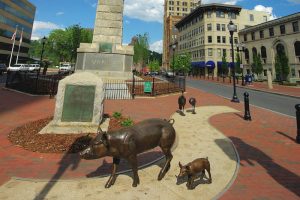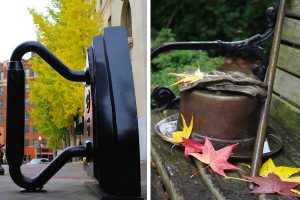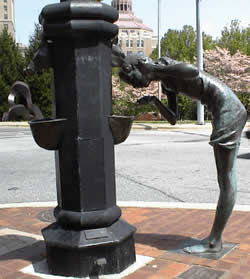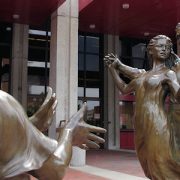Ask your neighbor to describe the Great Outdoors and you’ll get plenty of answers peppered with words like “trees,” “trails,” “rivers,” “sky,” and other hallmarks of untamed areas. You’re a lot less likely to get a description of downtown Asheville, but it’s home to one of the most interesting hikes you’ll ever find. It’s kind of a museum without walls – all under a beautiful skyline.

Courtesy of RomanticAsheville.com
The Urban Trail is just 1.7 miles, but it winds through vibrant city streets and tells Asheville’s history through public sculptures at 30 stops. These bronze plaques and art pieces are so familiar, they’re easy to overlook, but serve as reminders of the legends and lore that are part of the rich fabric of our little corner of the world. Mostly local artists created the vibrant bronze sculptures and other art works that are found at each station.
A small group of dedicated friends and neighbors started the Urban Trail in 1991 as a way to help revitalize downtown. They decided to divide the trail into five distinct eras, each of which has a symbol carved into pink granite blocks placed in the sidewalk along the way.
Highlights include:
The Gilded Age (1880-1930) is marked with a feather. Covering Asheville’s post-Civil War boom to the Great Depression, you’ll find the bronze pigs and turkeys in front of the Vance Monument that represents the Buncombe Turnpike, a busy dirt thoroughfare used by travelers in the early 19th century. The rails represent the arrival of the train in 1880 and the electric trolley in 1889. This section of the trail includes the giant iron in front of the 1926 Flat Iron Building, metal cats on Wall Street, and musicians and dancers in front of the U.S. Cellular Center representing the musical heritage of the Blue Ridge.

Courtesy of RomanticAsheville.com
A horseshoe marks The Frontier Period (1784-1880). With just two stops, it’s the shortest part of the trail. It recognizes Lexington Avenue’s previous life as the city’s home to produce markets and livery stables. A wide-eyed boy on stilts represents Richard Sharp Smith, supervising architect of Biltmore and designer of many downtown buildings.
No history of Asheville would be complete without a bit of attention to Thomas Wolfe, author of Look Homeward, Angel and one of Asheville’s favorite sons. The Times of Thomas Wolfe (1900-1938) is marked by a replica of the angel sold by his father. One of the most popular stops is entitled “Wolfe’s Neighborhood” and gives a panoramic view of Asheville as it would have been seen in the early 20th century. “On the Move” outside of Asheville Community Theatre is another interesting sculpture that represents the history of transportation. Spin its wheel to hear 11 different sounds ranging from trains to horse-drawn wagons.
The Era of Civic Pride (1876-1903) celebrates the role of local government. It’s marked by replica of the sixth Buncombe County Courthouse, which stood during the period. Among the five stops, you’ll find an historic bell similar to the one that hung in the 1892 City Hall and a little girl in bronze representing Childhood.

Courtesy of Asheville.com
The final leg of the hike is The Age of Diversity and is marked by an eagle, a nod to the historic significance of Eagle Street as the center of Asheville’s early African-American community. Markers commemorate craftsman James Vester Miller, “The Block,” and grand The Eagle Hotel that once stood near the stagecoach stop.
The self-guided tour begins and ends at Pack Square Park and takes about two hours to complete in its entirety. It can be made shorter by covering just part of the trail, but it’s you’ll find it hard not to be inspired to visit all time periods. It’s hard not to be taken in by the many tempting distractions of downtown, too, which prove adventure is where you find it whether you’re on the trail or on the town.
Grab a map at Diamond Brand Outdoors in the Aloft Hotel on 53 Biltmore Avenue or download one from the City of Asheville’s website.
For more information, visit RomanticAsheville.com.













